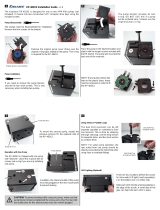
Calibrating the Compass
1
Select an option:
• If you are performing this procedure as part of the Sea
Trial Wizard, select Begin.
• If you are performing this procedure outside of the Sea
Trial Wizard, from the heading screen, select Menu >
Setup > Dealer Autopilot Setup > Compass Setup >
Calibrate Compass > Begin.
2
Follow the directions on the helm control until calibration is
complete, taking care to keep the boat as steady and flat as
possible.
The boat should not list during calibration.
3
Select an option:
• If the calibration completes successfully, select Done.
• If the calibration is not successful, select Retry and repeat
steps 1 through 3.
When the calibration is complete, calibration values are
displayed. You can use these values to determine the quality of
the calibration procedure.
Compass-Calibration Values
After the compass calibration process is complete, you can
review the results provided on the helm control to determine the
successfulness of the calibration.
Magnetic Environment: Indicates the level of distortion of the
Earth's magnetic field at the mounting location.
• A value of 100 indicates the device experiences no
magnetic interference at the mounting location.
• If this value is low, you might need to move the CCU and
calibrate the compass again.
• A value of 100 is ideal, but it is not necessary for the
autopilot to function correctly. If the CCU is mounted in an
optimal location on your boat, you should continue
configuring the autopilot and evaluate the performance
again later.
Spin Quality: Represents how level the boat remained during
the compass-calibration process.
• A value of 100 indicates the boat remained perfectly level
during compass calibration.
• If this value is low, you might need to calibrate the
compass again.
Performing the Autotune Procedure
Before you can begin this procedure, you must have a large
stretch of open water available.
1
Adjust the throttle so the boat travels at a typical cruising
speed that provides responsive steering.
2
Select an option:
• If you are performing this procedure as part of the Sea
Trial Wizard, select Begin.
• If you are performing this procedure outside of the Sea
Trial Wizard, from the heading screen, select Menu >
Setup > Dealer Autopilot Setup > Autopilot Tuning >
Autotune > Begin.
The boat performs various zigzag motions while the Autotune
is in progress.
3
After the procedure is finished, follow the on-screen
instructions.
4
Select an option:
• If the Autotune procedure is not successful, but you have
not reached maximum cruising speed, increase the speed
and repeat steps 1 through 3 until the Autotune
procedure completes successfully.
• If the Autotune procedure is not successful, and you have
reached maximum cruising speed, reduce your speed to
the initial Autotune speed and select Alternate Autotune
to begin an alternate procedure.
When the Autotune procedure is complete, gain values are
displayed. You can use these values to determine the quality of
the Autotune procedure.
Autotune Gain Values
After the autotune procedure is complete, you can review the
gain values provided on the helm control. You can record these
numbers for reference if you want to run the autotune procedure
at a later time or if you want to manually adjust the gain settings
(not recommended) (Adjusting the Autopilot Gain Settings).
Gain: Sets how tightly the autopilot holds the heading and how
aggressively it makes turns.
Counter Gain: Sets how aggressively the autopilot adjusts any
over-steering after making a turn.
Setting North
Before you can begin this procedure, you must have a large
stretch of open water available.
NOTE: If you followed the guidelines when mounting the CCU,
this procedure may not be necessary (CCU Mounting and
Connection Considerations).
This procedure appears if the autopilot is connected to an
optional GPS device (Connecting Optional NMEA 2000 Devices
to the Autopilot System), and the device has acquired a GPS
position. During this procedure, the autopilot uses the GPS
heading information to calibrate north on the autopilot system.
If you do not have a GPS device connected, you are prompted
to set the fine heading adjustment instead (Setting the Fine
Heading Adjustment).
1
Drive your boat at cruising speed in a straight line.
2
Select an option:
• If you are performing this procedure as part of the Sea
Trial Wizard, select Begin.
• If you are performing this procedure outside of the Sea
Trial Wizard, from the heading screen, select Menu >
Setup > Dealer Autopilot Setup > Compass Setup >
Set North > Begin.
3
Continue to drive the boat at cruising speed in a straight line
and follow the on-screen instructions.
4
Select an option:
• If the calibration completes successfully, select Done.
• If the calibration is not successful, repeat steps 1 through
3.
Setting the Fine Heading Adjustment
This procedure appears only if you do not have an optional GPS
device connected to the autopilot (Connecting Optional NMEA
2000 Devices to the Autopilot System). If the autopilot is
connected to a GPS device that has acquired a GPS position,
you are prompted to set north instead (Setting North).
1
Using a handheld compass, identify north.
2
Select an option:
• If you are performing this procedure as part of the Sea
Trial Wizard, adjust the fine heading setting until it
matches north on the magnetic compass.
• If you are performing this calibration outside of the Sea
Trial Wizard, from the heading screen, select Menu >
Setup > Dealer Autopilot Setup > Compass Setup >
Fine Heading Adjustment, and adjust the fine heading
setting until it matches north on the magnetic compass.
3
Select Done.
11

















